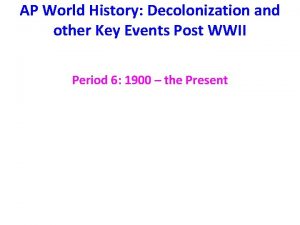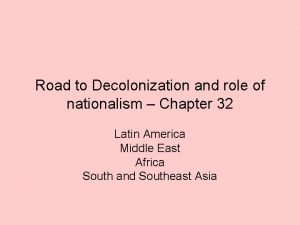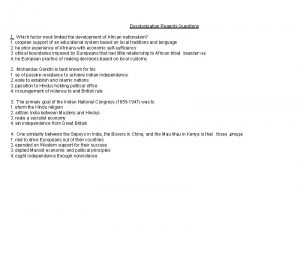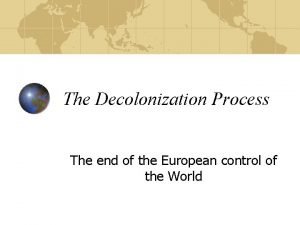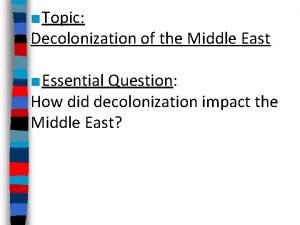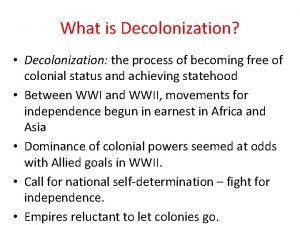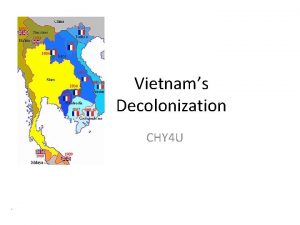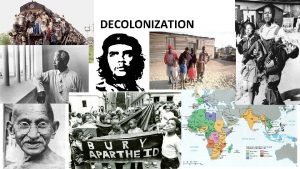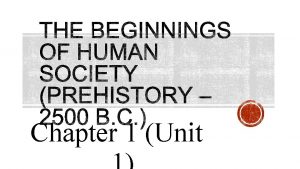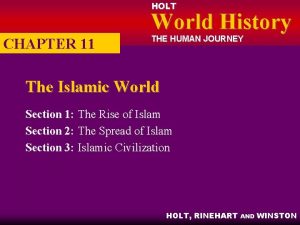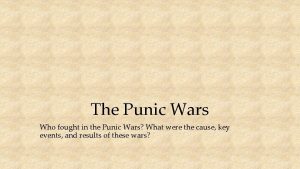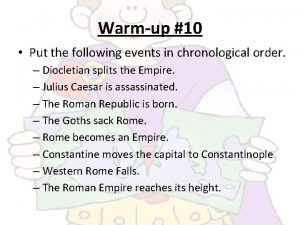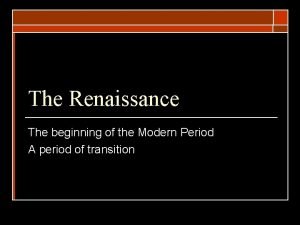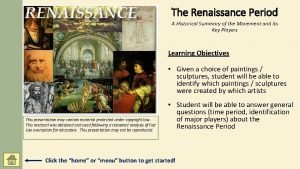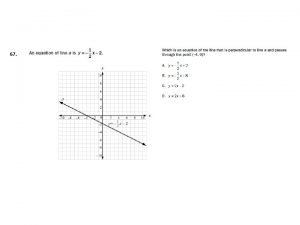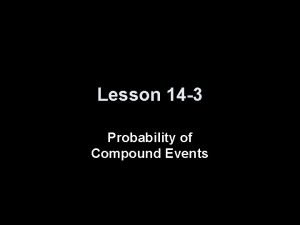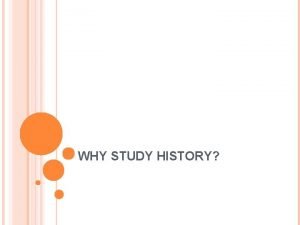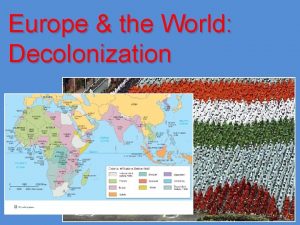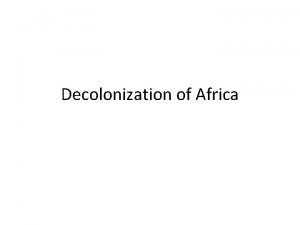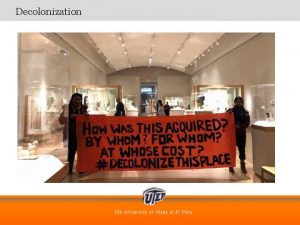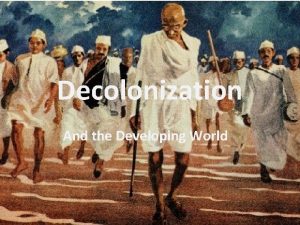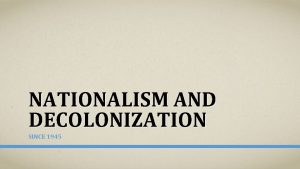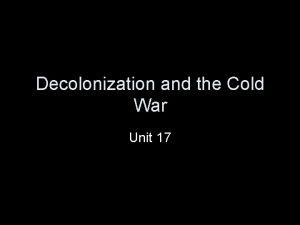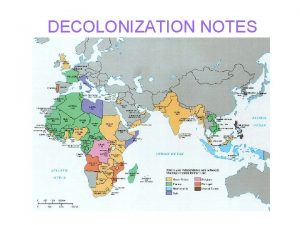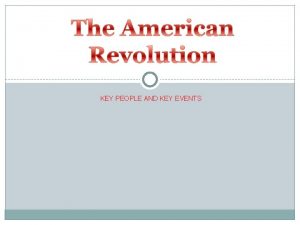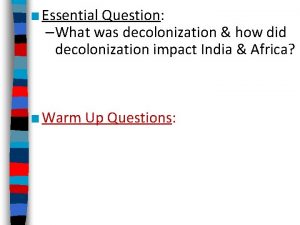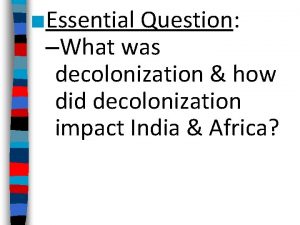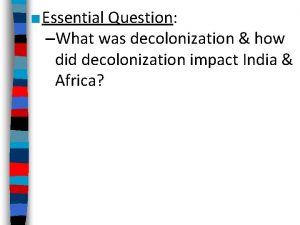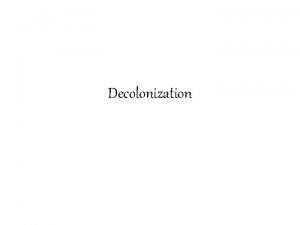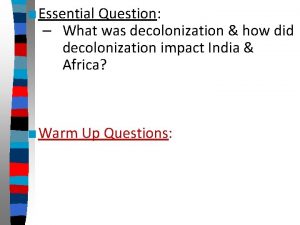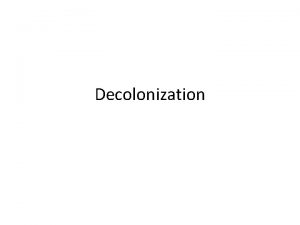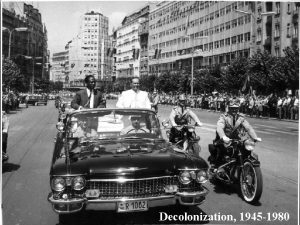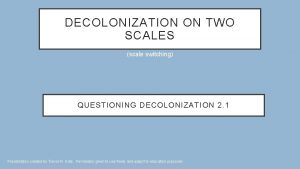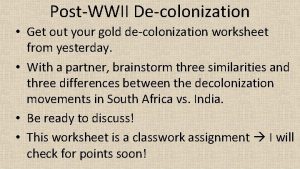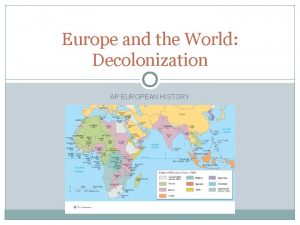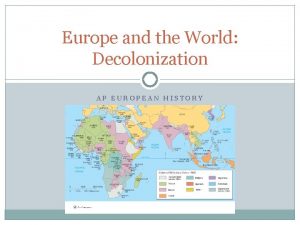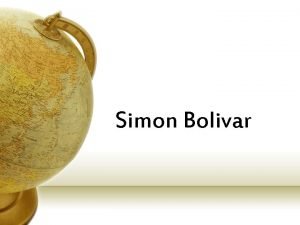AP World History Decolonization and other Key Events




































- Slides: 36

AP World History: Decolonization and other Key Events Post WWII Period 6: 1900 – the Present

I The Road to Independence A) The Atlantic Charter was drafted by U. S. President Franklin Roosevelt (left) and British Prime Minister Winston Churchill (right) in 1941. In it they voiced support for "the right of all peoples to choose the form of government under which they will live. ” B) The costs of WWII led to war debts and the need to rebuild Western Europe, leaving less money for maintaining overseas colonies.

II Independence in South Asia A) The Indian independence movement first gained momentum at the beginning of the 20 th century, and after WWI Gandhi organized the first of many effective passiveresistance campaigns in protest of Britain's oppressive rule in India. In the 1930 s the British feared losing India to the Axis. Gandhi rejected the British promises of Indian self-government after the war and organized the nonviolent "Quit India" campaign to hasten the British departure. British colonial authorities responded by jailing Gandhi and hundreds of others. B) Anti-British demonstrations accelerated after the war, and in 1947 the Indian National Congress reluctantly accepted the creation of Pakistan to appease the Muslim League and conclude the independence negotiations. On Aug 15, 1947, the Indian Independence Bill took effect. This lead to a period of religious turmoil in India and Pakistan that would result in the deaths of hundreds of thousands, including Gandhi, who was assassinated by a Hindu fanatic in January 1948 during a prayer vigil to an area of Muslim-Hindu violence. www. history. com


Independence in South Asia Continued… C) Pakistan was composed of East Pakistan and West Pakistan, separated by Indian territory. The state of Kashmir (mostly Muslim) shared borders with both India and West Pakistan. The argument over which nation would incorporate Kashmir led to the first India-Pakistan War in 1947– 48 and ended with UN mediation. Kashmir joined India, but the Pakistani Government continued to believe that Kashmir rightfully belonged to Pakistan. The U. S. looked to Pakistan for assistance in holding the line against communist expansion by joining the Southeast Asia Treaty Organization (SEATO) in 1954. Pakistan’s interest in SEATO stemmed from its desire to develop its military and defensive capabilities, which were substantially weaker than those of India. Both the US and the UK supplied arms to Pakistan in these years. Today the fighting continues. http: //history. state. gov/milestones/1961 -1968/india-pakistan-war

Independence in South Asia Continued… D) Inequalities between East and West Pakistan soon stirred up a sense of Bengali nationalism. When the Pakistan government declared that `Urdu and only Urdu' would be the national language, the Bangla-speaking Bengalis decided it was time to assert their cultural identity and a push for self-government. When the Awami League, a nationalistic party, won a majority in the 1971 national elections, the president of Pakistan, faced with this unacceptable result, postponed opening the National Assembly. Riots and strikes broke out in East Pakistan, the independent state of Bangladesh was unilaterally announced, and Pakistan sent troops to quell the rebellion. The ensuing war was one of the shortest and bloodiest of modern times, with the Pakistan army occupying all major towns, using napalm against villages, and slaughtering and raping villagers. Bangladeshis refer to Pakistan's brutal tactics as attempted genocide. In 11 days it was all over and Bangladesh, the world's 139 th country, officially came into existence. Sheikh Mujib, one of the founders of the Awami League, became the country's first prime minister in January 1972. ” http: //www. bangla 2000. com/bangladesh/history. shtm


Bangladesh Today A rally in Dhaka, the capital of Bangladesh 2013 Bangladeshi Village Women, 2008

III Japan Post WWII A) In Sept 1945, General Douglas Mac. Arthur took charge of the Supreme Command of Allied Powers (SCAP) and began the work of rebuilding Japan. Although Great Britain, the Soviet Union, and the Republic of China had an advisory role as part of an “Allied Council, ” Mac. Arthur had the final authority. The Allies punished Japan for its past militarism and expansion by convening war crimes trials in Tokyo. They dismantled the Japanese army. The SCAP introduced land reform, designed to benefit the majority tenant farmers and reduce the power of rich landowners. Mac. Arthur also tried to break up the large Japanese business conglomerates as part of the effort to transform the economy into a free market capitalist system. In 1947, Allied advisors dictated a new constitution; it downgraded the emperor’s status to that of a figurehead, gave greater rights to women, and renounced the right to wage war. B) However, the SCAP became concerned that a weak Japanese economy would increase the influence of communism. The final agreement allowed the US to maintain its bases in Okinawa and elsewhere in Japan, and the US promised Japan a bilateral security pact. http: //history. state. gov/milestones/1945 -1952/japan-reconstruction

Japan Post WWII Continued…. General Douglas Mac. Arthur Fred Korematsu C) In 1942, FDR signed an executive order forcing many Japanese Americans into internment camps, including Fred Korematsu challenged his conviction, and it went to the Supreme Court. The Supreme Court decided that the need to protect the country was a greater priority than the individual rights of the Japanese and Japanese Americans. "As long as my record stands in federal court, any American citizen can be held in prison or concentration camps without trial or hearing. I would like to see the government admit they were wrong and do something about it, so this will never happen again to any American citizen of any race, creed, or color. " —Fred Korematsu 1983

IV The Nuremberg Trials A) Held for the purpose of bringing Nazi war criminals to justice, the Nuremberg trials were a series of 13 trials held in Nuremberg, Germany, between 1945 and 1949. The defendants, who included Nazi Party officials along with German industrialists, lawyers and doctors, were indicted on such charges as crimes against peace and crimes against humanity. Hitler and two of his top associates, Heinrich Himmler and Joseph Goebbels had each committed suicide in the spring of 1945 before they could be brought to trial. B) 24 individuals were indicted, along with six Nazi organizations determined to be criminal (such as the “Gestapo, ” or secret state police). the international tribunal found all but three of the defendants guilty. 12 were sentenced to death, one in absentia, and the rest were given prison sentences ranging from 10 years to life behind bars. 10 of the condemned were executed by hanging on Oct 16, 1946. Hermann Göring (1893 -1946), Hitler’s designated successor and head of the German air force, committed suicide the night before his execution. There were 12 additional trials held at Nuremberg from Dec 1946 to April 1949. The findings at Nuremberg led directly to the Universal Declaration of Human Rights (1948), and the establishment of tribunals for war crimes committed in the former Yugoslavia (1993) and in Rwanda (1994). www. history. com

Defendants at the Nuremberg Trials

But Not All Nazis Were Put on Trial. . . “A secret history of the United States government’s Nazi-hunting operation concludes that American intelligence officials created a “safe haven” in the US for Nazis and their collaborators after WWII… The 600 page report, which the Justice Department has tried to keep secret for four years, provides new evidence about more than two dozen of the most notorious Nazi cases of the last three decades. . . ” By ERIC LICHTBLAU Published: November 13, 2010 The NY Times “The CIA organized Cold War spy networks that included former Nazis and failed to act on a 1958 report that fugitive Nazi war criminal Adolf Eichmann was living in Argentina, newly released CIA records show. The records were among 27, 000 pages of documents made public yesterday at the National Archives. They shed new light on the secret protection and support given to former Nazi officials and Nazi collaborators by U. S. intelligence agencies as fighting communism became the central aim of American foreign policy in the years after WWII. . . ” By Christopher Lee Washington Post June 7, 2006

V The Road to African Independence A) Recall the Pan African Movement was a movement of the early 20 th century to forge cultural unity of blacks around the world, to gain equal rights, education, and independence for Africa from imperialist nations. One of its main leaders was W. E. B. Du. Bois. B) The Negritude Movement was born out of the Pan African Movement. “Négritude is a cultural movement launched in 1930 s Paris by French-speaking black students from France's colonies in Africa and the Caribbean territories. These black intellectuals converged around issues of race identity and black internationalist initiatives to combat French imperialism. They found solidarity in their common ideal of affirming pride in their shared black identity and African heritage, and reclaiming African self-determination, self–reliance, and self–respect. C) Kwame Nkrumah gained independence for Ghana in 1957, leading the way for other African nations to follow. - Bertrade Ngo-Ngijol Banoum –Lehman College

Ghana, Africa “A State in the grip of neocolonialism is not master of its own destiny. It is this factor which makes neo-colonialism such a serious threat to world peace. ” Kwame Nkrumah Celebration of Ghana’s 57 th Year of Independence, 2014!

The Road to African Independence Continued… D) In 1948, the National Party (NP) won the all-white elections and passed apartheid laws that legalized racism and segregation. In the early 1960 s Nelson Mandela (1918 – 2013) and other anti-apartheid leaders were convicted and imprisoned on charges of treason. In May 1961, South Africa declared independence from Britain. In 1984, a new constitution allowed blacks and Asians a VERY limited role in the national government and control over their own affairs. In Feb 1990, President F. W. de Klerk, announced the unbanning of the anti-apartheid groups. Two weeks later, Nelson Mandela was released from prison. In 1991, the last apartheid era laws were abolished. The country's first nonracial elections were held on April 26 -28, 1994, resulting in Nelson Mandela becoming the first black President of South Africa on May 10, 1994 (through 1999). http: //globaledge. msu. edu/countries/south-africa/history Nelson Mandela

VI The Green Revolution A) The Green Revolution was a period when the productivity of global agriculture increased drastically as a result of new chemical fertilizers, synthetic herbicides and pesticides. The chemical fertilizers made it possible to supply crops with extra nutrients and, therefore, increase yield. The newly developed synthetic herbicides and pesticides controlled weeds, deterred or kill insects, and prevented diseases, which also resulted in higher productivity. B) In addition, high-yield crops were also developed and introduced. High-yield crops are crops that are specifically designed to produce more overall yield. A method known as multiple cropping was also implemented during the Green Revolution and lead to higher productivity. Multiple cropping is when a field is used to grow two or more crops throughout the year, so that the field constantly has something growing on it.

The Green Revolution Continued… Most industrial countries achieved sustained food surpluses by the second half of the 20 th century, but the colonial powers invested little in the food production systems of their colonies and former colonies. The Rockefeller and Ford foundations took the lead in establishing an international agricultural research system to help developing countries. The first investments were in research on rice and wheat. The breeding of improved varieties, combined with the expanded use of fertilizers, other chemical inputs, and irrigation, led to dramatic yield increases in Asia and Latin America, beginning in the late 1960 s. In 1968, this movement became known as the “Green Revolution”. Although the term Green Revolution originally described developments for rice and wheat, high-yielding varieties (HYVs) have since been developed for other major food crops important to developing countries, including sorghum, millet, maize, cassava, and beans… These changes more than doubled cereal production in Asia between 1970 and 1995, while population increased by 60 percent. Instead of widespread famine, cereal and calorie availability person increased by nearly 30 percent, and wheat and rice became cheaper. Latin America experienced significant gains as well, but the impact in Sub-Saharan Africa was much more modest. Poor infrastructure, high transport costs, limited investment in irrigation, and pricing and marketing policies that penalized farmers made the Green Revolution technologies too expensive or inappropriate for much of Africa. http: //www. ifpri. org/sites/default/files/pubs/ib/ib 11. pdf

The Green Revolution Continued… C) Rachel Carson, a scientist, wrote Silent Spring (1962) in which she warned against the use of pesticides such as DDT and other chlorinated hydrocarbons. Carson. A single application on a crop, she wrote, killed insects for months, and remained toxic in the environment even after it was diluted by rainwater. Carson concluded that DDT and other pesticides had irrevocably harmed birds and animals and had contaminated the entire world food supply. The book's famous chapter, "A Fable for Tomorrow, " depicted a nameless American town where all life -- from fish to birds to human children -- had been "silenced" by the effects of DDT. http: //www. nrdc. org/health/pesticides/hcarson. asp “…DDT kills mosquitoes, which carry malaria, which was all but eradicated before DDT was banned… The Washington Post concedes that "numerous" deaths might have been prevented by DDT… According to these CDC figures, malaria kills more than 800, 000 children under age five every year. Every year, 800, 000 small children die from malaria, a disease once nearly eradicated. Ponder that. ” http: //www. forbes. com/sites/henry miller/2012/09/05/rachel-carsonsdeadly-fantasies/

The World Wildlife Fund: Did It Help or Hurt Africa? “The world’s leading conservation organization, WWF works in 100 countries and is supported by 1. 2 million members in the United States and close to 5 million globally. WWF’s unique way of working combines global reach with a foundation in science, involves action at every level from local to global, and ensures the delivery of innovative solutions that meet the needs of both people and nature. ” www. worldwildlife. org “In Nov. 2011, Prince Charles, who serves as president of WWF UK, visited Tanzania to present five local leaders with “Living Planet” awards for their work. According to the London newspaper The Telegraph, ‘Shortly before the prince’s arrival, it was revealed that thousands of villagers had been evicted from the forest, their huts torched. . . This was carried out by the Tanzanian government’s Forestry Division, with which the WWF has been working. ’” By Drew Johnson 2012 "If I were reincarnated I would wish to be returned to earth as a killer virus to lower human population levels" - Prince Philip Duke of Edinburgh, leader of the World Wildlife Fund, Dec 1995.

VII 1979 Iranian Revolution A) In 1941, British and Soviet troops occupied Iran, and the Shah (the leader of Iran since 1941) was forced to abdicate in favor of his son, Mohammad Reza. However, in the early 1950 s, the Shah was eclipsed by Mohammad Mosaddeq, an Iranian nationalist who convinced the Parliament to nationalize Britain's extensive oil interests in Iran. Reza, who maintained close relations with Britain and the US, opposed the decision. In 1953, Mohammad Reza attempted to dismiss Mosaddeq, but the premier's popular support was so great the Shah (Reza) was forced out of Iran. B) A few days later, British and US agents orchestrated a coup d'etat against Mosaddeq, and the Shah returned to take power as the sole leader of Iran. He became a close Cold War ally of the US in Southwest Asia (the Middle East). C) In 1963, the Shah launched his "White Revolution" that included land reform, infrastructure development, voting rights for women, and education. Although these programs were applauded by many in Iran,

1979 Iranian Revolution Continued… Islamic leaders were critical of what they saw as the westernization of Iran. D) Ruhollah Khomeini, a Shiite cleric, wanted to overthrow the Shah, rid Iran of “Western” influences, and establish an Islamic state. In 1964, Khomeini was exiled and settled across the border in Iraq, where he sent radio messages to incite his supporters. E) The Shah saw himself as a Persian king and in 1971 held an extravagant celebration of the 2, 500 th anniversary of the pre-Islamic Persian monarchy. Religious discontent grew, and the shah became more repressive, using his brutal secret police force to suppress opposition. This alienated students and intellectuals in Iran, and support for Khomeini grew. Discontent was also rampant in the poor and middle classes, who felt that the economic developments of the White Revolution had only benefited the ruling elite.

1979 Iranian Revolution Continued… F) In 1978, anti-Shah demonstrations broke out in Iran's major cities. On Sept 8, 1978, the Shah's security force fired on a large group of demonstrators, killing hundreds. Khomeini called for the Shah's immediate overthrow, and on Dec 11 a group of soldiers mutinied and attacked the Shah's security officers; the Shah fled, eventually entering the US in Oct 1979 for medical treatment of his cancer. G) On Nov 4 1978, in Tehran, Islamic militants responded by storming the US embassy and taking the staff hostage. With the approval of Khomeini, the militants demanded the return of the Shah to Iran to stand trial for his crimes. The United States refused to negotiate, and 52 American hostages were held for 444 days. Mohammad Reza Shah Pahlavi died in Egypt in July 1980.

Imam Ruhollah Musavi Khomeini Mohammad Reza Pahlavi

Iranian Hostage Crisis “On Nov 4, 1979, a group of Iranian students stormed the U. S. Embassy in Tehran, taking more than 60 American hostages. The immediate cause of this action was President Jimmy Carter’s decision to allow Iran’s deposed Shah, a pro-Western autocrat, to come to the US for cancer treatment… it was also a dramatic way for the student revolutionaries to declare a break with Iran’s past and an end to American interference in its affairs, and to raise the profile of the revolution’s leader, the anti. American cleric Ayatollah Ruhollah Khomeini. The students set their hostages free on January 21, 1981, 444 days after the crisis began and just hours after President Ronald Reagan delivered his inaugural address. Many historians believe that hostage crisis cost Jimmy Carter a second term as president. ” www. history. com

VIII Iran Iraq War 1980 - 1988 A) The Iran – Iraq War began on Sept. 22, 1980. The causes of the war lay in a number of territorial and political disputes between Iraq and Iran. Iraq wanted to seize control of the rich oil-producing Iranian border region of Khuzestan, a territory inhabited largely by ethnic Arabs. Iraqi president Saddam Hussein wanted to reassert his country’s sovereignty over both banks of the Shaṭṭ al-ʿArab, a river formed by the flowing together of the Tigris and Euphrates rivers that was historically the border between the two countries. Saddam was also concerned over attempts by Iran’s Islamic revolutionary government to incite rebellion among Iraq’s Shiite majority. B) The fighting ended in 1988 with a cease-fire, but the withdrawal of troops did not take place until the signing of a formal peace agreement on Aug. 16, 1990. http: //www. britannica. com/EBchecked/topic/293527/Iran-Iraq-War

Iran Iraq War 1980 – 1988 Continued…

IX The Iran – Contra Affair 1986 - 1987 “The Iran-contra affair consisted of 3 interconnected parts: The Reagan administration sold arms to Iran, a country desperate for arms during its war with Iraq; in exchange for the arms, Iran was to use its influence to help gain the release of Americans held hostage in Lebanon; and the arms were purchased at high prices, with the excess profits diverted to fund the Reagan-favored "contras" fighting the Sandinista government in Nicaragua. It was a grand scheme that violated American law and policy all around: Arms sales to Iran were prohibited; the U. S. government had long forbidden ransom of any sort for hostages; and it was illegal to fund the contras above the limits set by Congress. The first press revelations occurred in Nov 1986, and were followed by 3 investigations, and finally by a federal prosecutor, eventually resulting in the convictions of several members of the Reagan administration. Reagan himself was never charged with any offense, although opinions differed about his knowledge of, and culpability for, the affair. ” http: //www. washingtonpost. com/wpsrv/politics/special/clinton/frenzy/iran. htm

The Iran – Contra Affair Continued… Lieutenant Colonel Oliver North of the National Security Council admitted to diverting funds from arms sales to Iran to the Contras, with the full knowledge of NSA Adviser Admiral John Poindexter and of President Reagan. Poindexter resigned, and North was fired. In Nov 1986, Reagan went on TV and denied that any such operation had occurred. He retracted the statement a week later, insisting that the sale of weapons had not been an arms-for-hostages deal. Polls showed that only 14 percent of Americans believed the president when he said he had not traded arms for hostages.

The Iran – Contra Affair Continued… Eugene H. Hasenfus is a US citizen who was alleged by Nicaragua Sandinista authorities to be employed by the U. S. CIA, after the aircraft he was aboard crashed on Nicaraguan soil. The photo above shows Sandinista soldiers holding Eugene Hasenfus captive after his cargo plane was shot down while delivering supplies to the Contras in October 1986.


X China under Mao A) Mao Zedong and his communist supporters had been fighting against what they claimed was a corrupt t Nationalist government in China since the 1920 s. Despite U. S. support for the Nationalist regime, Mao's forces were victorious in 1949 and drove the Nationalist government to the island of Taiwan. B) On October 1, 1949, the People's Republic of China was formally announced, with Mao Zedong as its leader. He would remain in charge of the nation until his death in 1976. C) The Great Leap Forward was a push by Mao Zedong to change China from a predominantly agrarian (farming) society to a modern, industrial society in just five years. Between 1958 and 1960, millions of Chinese citizens were moved onto communes. Some were sent to farming cooperatives, while others worked in small manufacturing. All work was shared on the communes; from childcare to cooking, daily tasks were collectivized. The Great Leap Forward was supposed to be a 5 -year plan, but it was called off after just three years.

China under Mao Continued… “The worst catastrophe in China’s history, and one of the worst anywhere, was the Great Famine of 1958 to 1962, and to this day the ruling Communist Party has not fully acknowledged the degree to which it was a direct result of the forcible herding of villagers into communes under the “Great Leap Forward” that Mao Zedong launched in 1958. In all, the records I studied suggest that the Great Leap Forward was responsible for at least 45 million deaths. Between 2 and 3 million of these victims were tortured to death or summarily executed, often for the slightest infraction. People accused of not working hard enough were hung and beaten; sometimes they were bound and thrown into ponds. Punishments for the least violations included mutilation and forcing people to eat excrement. One report dated Nov. 30, 1960, and circulated to the top leadership — most likely including Mao — tells how a man named Wang Ziyou had one of his ears chopped off, his legs tied up with iron wire and a 10 -kilogram stone dropped on his back before he was branded with a sizzling tool. His crime: digging up a potato. . . ” By FRANK DIKÖTTER Published: December 15, 2010 NY Times

China under Mao Continued… Cafeteria on a Commune On the top right a man is holding a “Little Red Book”; a book of selected statements from speeches and writings by Mao Zedong that was widely distributed during the Cultural Revolution. The most popular versions were printed in small sizes that could be easily carried and were bound in bright red covers.

HW Questions 1. Fill in your period 6 Chart for the Chinese Civil War (Part 2), and the Iran – Iraq War. 2. Describe the process of “Decolonization” in South Asia OR Africa. 3. How did the Green Revolution and Rachel Carson’s Silent Spring affect developing nations? In your opinion, was it for the better or the worse and why? 4. Was Mao’s Great Leap Forward more or less justified as Stalin’s 5 Year Plan? 5. Were the US’s actions in Iran justified? Use historical evidence to support your answers!!

Key Vocabulary 1979 Iranian Revolution Apartheid Atlantic Charter Bangladesh Ghana Great Leap Forward Green Revolution Imam Ruhollah Musavi Khomeini India – Pakistan War Iran – Iraq War Iran-Contra Affair Iranian Hostage Crisis Kashmir Korematsu Kwame Nkrumah Mohammad Reza Pahlavi Negritude Movement Nelson Mandela Nuremburg Trials Pakistan Pan African Movement Rachel Carson Sandinistas Silent Spring South Africa Southeast Asia Treaty Organization (SEATO) World Wildlife Fund (WWF)
 Decolonization ap world history
Decolonization ap world history Nationalism and decolonization
Nationalism and decolonization Decolonization regents questions
Decolonization regents questions Decolonization of asia
Decolonization of asia Decolonization acrostic poem
Decolonization acrostic poem Decolonization of the middle east
Decolonization of the middle east What is decolonization
What is decolonization Vietnam decolonization
Vietnam decolonization Decolonization
Decolonization Ap world history chapter 25 africa and the atlantic world
Ap world history chapter 25 africa and the atlantic world Written and other recorded events of people
Written and other recorded events of people Mutually exclusive events vs not mutually exclusive events
Mutually exclusive events vs not mutually exclusive events Bad dangerous tour
Bad dangerous tour Holt world history the human journey
Holt world history the human journey Key partners adalah
Key partners adalah Contoh bisnis model canvas makanan pdf
Contoh bisnis model canvas makanan pdf Who fought in the punic wars
Who fought in the punic wars Review exercise terms and events answer key
Review exercise terms and events answer key Types of positions
Types of positions Place the following events in chronological order
Place the following events in chronological order Floor plan grade 10 maths literacy
Floor plan grade 10 maths literacy Types of maps in mathematical literacy grade 12
Types of maps in mathematical literacy grade 12 Maps, plans and other representations of the physical world
Maps, plans and other representations of the physical world Maps, plans and other representations of the physical world
Maps, plans and other representations of the physical world Dam of the forest chapter 17
Dam of the forest chapter 17 Key events in the renaissance
Key events in the renaissance Key events in the renaissance
Key events in the renaissance Language
Language Independent or dependent
Independent or dependent Probability of compound events answer key
Probability of compound events answer key Vipers retrieval
Vipers retrieval What is key events in a story
What is key events in a story Key events in jesus life
Key events in jesus life Gas exchange key events in gas exchange
Gas exchange key events in gas exchange Secular music
Secular music History helps us understand people and society
History helps us understand people and society World history and geography final exam study guide
World history and geography final exam study guide
